Rearranged luggage since we are leaving some here at the Marriott while in the Sacred Valley. On Peru's Latam Airline, luggage weight limits are lower than on American so a bit of juggling; luckily all we need are casual, hiking clothes. Marriott made arrangements for CMV transport to the airport. Plane was late and then sat for about 15 minutes on the bus taking passengers to the plane. Hurray, more room betweeen seats, almost double than on American flight. Waited on runway about 20 min.
CUSCO--Arrived at noon, only about 30 min late. Fast getting baggage. Man came up to Randy asked if we were with Hernan (the guide that was going to meet us at the airport); he took us to him right outside the terminal. Nice big 12-seater van; very roomy. The driver Issac spoke some English but not like Hernan.
CUSCO--Arrived at noon, only about 30 min late. Fast getting baggage. Man came up to Randy asked if we were with Hernan (the guide that was going to meet us at the airport); he took us to him right outside the terminal. Nice big 12-seater van; very roomy. The driver Issac spoke some English but not like Hernan.
Cusco is much larger than we expected--400,000 people. Lots of interesting information from Hernon as we drove down the main street, which was very crowded with lots of traffic. Originally the city was laid out in the shape of a puma. Statues in all the roundabouts. Most impressive was the Pachacutec statue "he who shakes the earth." One of the most important and powerful Inca Emperors, he built Cusco. When the Spanish took over, they destroyed Inca structures and built their stucco-walled buildings on top of Inca stone bases.
Stopped for a quick bite to eat. Isaac dropped us off and we followed Hernan through the verrrrry narrow sidewalk/street to PanKracio, where they have a grill making fresh sandwiches. Huge so we split omo fino saltado (chicken). Barb got vegie with avacado, tomato, lettuce with great cilantro mayo. Great local place that we would never have found on our own.
No wonder Issac dropped us off; don't know how he could get the van through here. Walked by ruins that were an old Inca Palace where the royal people would have lived.
Very bumpy ride driving through outskirts. Sure would not like living in these houses with such steep stairs up the mountain.
Stopped for a quick bite to eat. Isaac dropped us off and we followed Hernan through the verrrrry narrow sidewalk/street to PanKracio, where they have a grill making fresh sandwiches. Huge so we split omo fino saltado (chicken). Barb got vegie with avacado, tomato, lettuce with great cilantro mayo. Great local place that we would never have found on our own.
No wonder Issac dropped us off; don't know how he could get the van through here. Walked by ruins that were an old Inca Palace where the royal people would have lived.
Very bumpy ride driving through outskirts. Sure would not like living in these houses with such steep stairs up the mountain.
SACRED VALLEY is a fertile stretch of land used for farming in the days of the Incas. Stretching for 37 miles from just outside Cusco towards Aguas Calientes, it is home to some of the best preserved Incan architecture in Peru.
Staying here first to acclimate better to the elevation since the altitude is lower than Cusco. (Cusco 11,152' Urubamba 9,420' Machu Picchu 7,971') Took diamox to prevent any altitude sickness (had no problems).
Stopping to see the sights along the way to the hotel in Urubamba.
Staying here first to acclimate better to the elevation since the altitude is lower than Cusco. (Cusco 11,152' Urubamba 9,420' Machu Picchu 7,971') Took diamox to prevent any altitude sickness (had no problems).
Stopping to see the sights along the way to the hotel in Urubamba.
Chinchero is believed to be the mythical birthplace of the rainbow. Village is mainly mud brick (adobe) houses. Locals are primarily of Quechua descent and still maintain their colorful traditional dress. Interesting learning about the women's hats that are unique to the different villages. Here they wear round ones and the top-hat kind.
Weaving Coop maintains Chinchero's centuries-old tradition. Spent a little over an hour here.
Weaving Coop maintains Chinchero's centuries-old tradition. Spent a little over an hour here.
Local women demonstrated the traditional weaving process of cleaning the wool, dying the yarn, and creating the textiles. Neat to see how they create the different colors by making dyes from all sorts of natural plants including fruits, vegetables, roots, even bugs (tiny white parasite beetles inside the cactus are smashed, which turns red)!
The ladies were super friendly and we enjoyed the mate de coca tea they served. Left a tip for the cooperative as well as purchased their quality alpaca scarves, gloves, sweaters, etc. Randy did lots of bargaining and teased the ladies, who have a great sense of humor. Good thing Hernan, who grew up in the Sacred Valley and speaks Quechua, could translate for us!
The ladies were super friendly and we enjoyed the mate de coca tea they served. Left a tip for the cooperative as well as purchased their quality alpaca scarves, gloves, sweaters, etc. Randy did lots of bargaining and teased the ladies, who have a great sense of humor. Good thing Hernan, who grew up in the Sacred Valley and speaks Quechua, could translate for us!
Beautiful drive through the farming valley's lush green fields full of blooming crops such as potatoes and quinoa. People working in the fields and some relaxing on a sunny Sunday afternoon waving as we passed. Fun watching the antics of all the baby sheep as they were being herded home.
Moray Agricultural Terraces - Looked down from the high plateau at this Inca archaeological site's impressively deep amphitheater-like terraces.
- One of the major limitations of the Andean landscape is the steepness of the mountain slopes. The answer: Terracing. Wari', an indigenous people of Brazil, started to grow potatoes, maize, and other native crops on graduated terrace steps.
Amazed at the different levels of lush green concentric terraces carved into a huge earthen bowl, each layer having its own microclimate, according to how deep it is into the bowl. Today it’s believed that this design allowed the Incas to test what conditions allowed certain types of fruits and vegetables to flourish and to genetically mix different species to survive droughts.
Walked half way around the top with views of surrounding mountains in the background that certainly took your breath away.
Very interesting seeing the local activities along the drive.
Crazy "off-roading" drive on the zigzag road with dramatic glacier-topped mountain views--worth every bump.
Very interesting seeing the local activities along the drive.
Crazy "off-roading" drive on the zigzag road with dramatic glacier-topped mountain views--worth every bump.
Maras Village is an old Inca town from the 1400's. Streets extremely narrow; only room for one vehicle. Had to wait while two men were walking their cow through town. Statue in Square is the village's "coat of arms"
Salt Ponds - Steep road up to view the amazing ponds created before Christ. Situated inside a red-rock canyon, the ponds tumble down the mountainside looking like a red-brown-white patchwork quilt. Harvested by local families, they have to hike down, get the salt, and then carry the very-heavy bags all the way back to the top! No one here now because it's the rainy season so the pools are full of water.
Salt Ponds - Steep road up to view the amazing ponds created before Christ. Situated inside a red-rock canyon, the ponds tumble down the mountainside looking like a red-brown-white patchwork quilt. Harvested by local families, they have to hike down, get the salt, and then carry the very-heavy bags all the way back to the top! No one here now because it's the rainy season so the pools are full of water.
- History: The salt ponds were built in AD200-AD900 by the Chanapata culture, pre-dating the Incas. The terraces are known in Quechua as Kachi Raqay and they’re situated at at an elevation of 9,843 feet above sea level. The salt forms from an underground hypersaline spring and are harvested by hand. There are about 5,000 ponds, each belonging to a local family (the size of the pond relative to the family size.)
Vendors sell the salt, etc. Bought tiny packet of salt as well as some chocolate bars (no so good; very grainy texture).
Sure was a BUSY day!
Arrived at the Aranwa Hotel around 7 pm. Grounds look gorgeous; can't wait to see them in the daylight. Light dinner in the hotel dining room: appetizers; pizza; chicerone (pork belly--Randy sure is hooked on this); all very good. Collapsed into bed!(Hotel details in next entry)
Arrived at the Aranwa Hotel around 7 pm. Grounds look gorgeous; can't wait to see them in the daylight. Light dinner in the hotel dining room: appetizers; pizza; chicerone (pork belly--Randy sure is hooked on this); all very good. Collapsed into bed!(Hotel details in next entry)

 Urubamba, Gobierno Regional de Lima, Peru
Urubamba, Gobierno Regional de Lima, Peru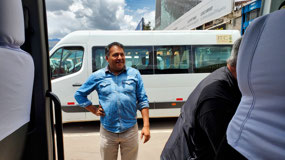

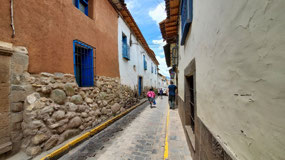
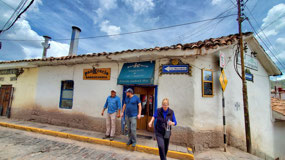
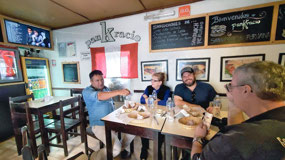
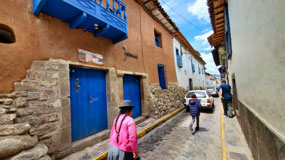
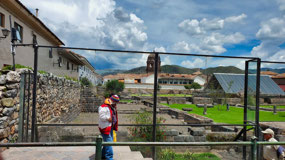
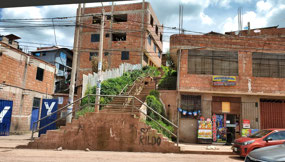
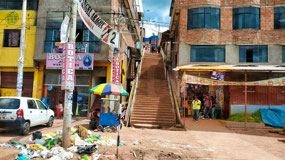
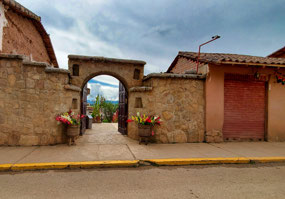
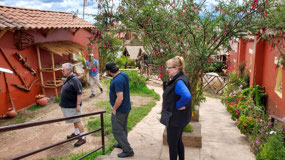
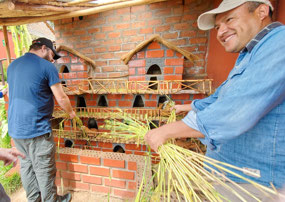

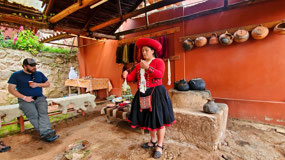
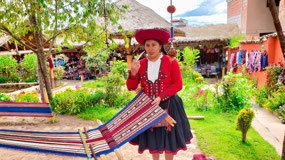

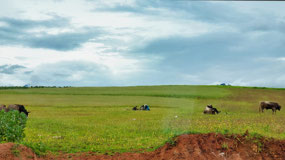
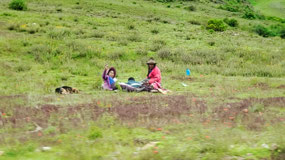
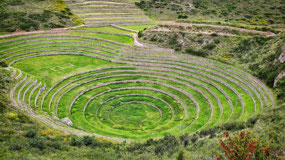
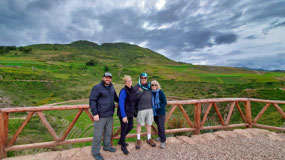
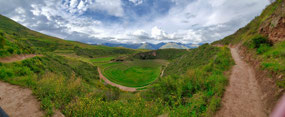
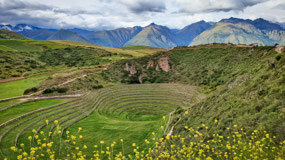
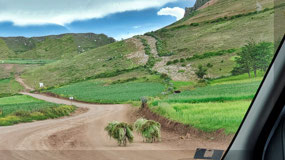
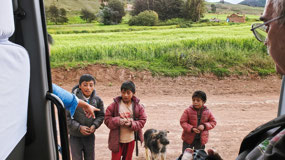
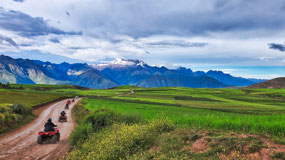
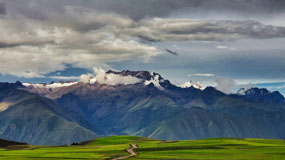

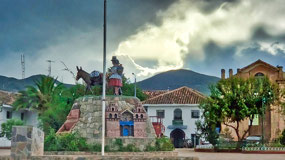
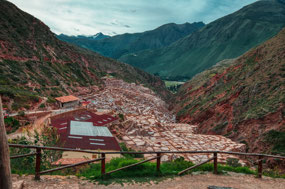
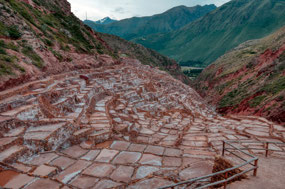


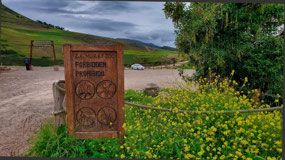
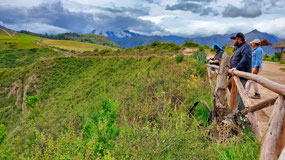
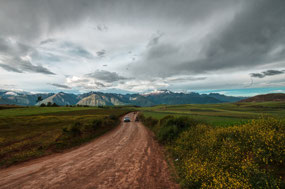
2025-05-23